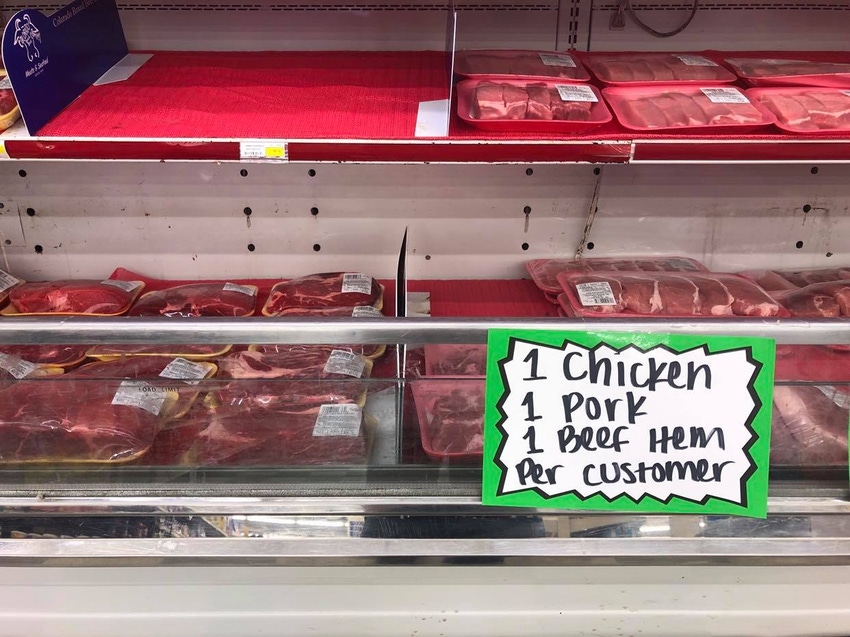Total meat department sales exceeded $1.6 billion for week ending May 3.
May 13, 2020

Despite the nonstop evolution of shopping patterns during the past couple of months, there has been one constant: The meat department has been the undisputed sales leader. Anne-Marie Roerink, principal and founder of 210 Analytics, reported that even though the prior week's sales gain of 50% seemed tough to beat, the prominent media coverage of meat plant closures recently drove another wave of shoppers to stock up on meat and poultry.
Analytics company IRI revealed that meat department dollar sales for the week ending May 3 were up 51.3%, while volume increased 37.2%. Year-to-date through May 3, meat department dollar sales were up 23.3%, boasting double-digit growth for eight weeks running. Year-to-date volume sales through May 3 were up 17.1% over the same period in 2019.
Roerink noted that, over the past two weeks, many stores have put purchase limits in place for certain cuts or limited the total number of packages of meat each customer could purchase. However, she said supply is likely to continue to affect the dollar and volume performance in weeks to come.
“Pork production rebounded 15% from historically low levels last week but continues to trail 2019 by 24%,” said Christine McCracken, executive director of food and agribusiness for Rabobank. “The beef industry has been slower to recover, with a 6% improvement since last week, and is still 32% below 2019 volumes.”
McCracken said nearly all U.S. plants should be operational in the coming week but added that labor shortages will continue to limit industry volumes to 70-80% of normal levels.
“Labor challenges have forced the closure of plants in Europe and Brazil in the past week. U.S. protein inventories are depleted, with retail and foodservice buyers drawing on the same limited supply,” she explained.
This limited supply is felt at retail, Roerink noted. Many consumers responding to the "Retail Feedback Group Constant Customer Feedback" system commented on sparse inventory levels during the week of May 3. One consumer said, “The chicken was mostly out [of stock]. I know that you cannot control what people are going to hoard, and it is hard to keep items in stock, through no fault of your own. There were only some wings and some drumsticks and one lonely whole chicken. I was looking for fresh chicken breasts.”
Another wrote about finding “a poor selection of meat in the refrigerated cases. Everything looked sparse. Some meat has not been available for two weeks, such as pork chops.”
Supply chain issues affect prices
The recent supply chain woes have affected wholesale and retail prices.
“Beef prices spiked to new highs this week and more than doubled year-ago levels, driven by ongoing strength in chucks and rounds,” McCracken said.
Roerink relayed that tight pork supplies have helped buoy prices to levels not seen since 2014. Further, renewed foodservice interest drove sharply higher pork belly prices, which doubled in the past two weeks, while loin prices were up 39% over the same period.
Chicken prices were also stronger on tighter supplies of beef and pork. Prices of boneless breast meat were 23% higher week over week because the industry lacks labor to debone and as supplies of ground beef have become scarce.
IRI’s retail price per volume insights also show significant upward pressure on retail prices of beef, pork and lamb for the week ending May 3 versus the same week in 2019. Upward pressure on the price per volume of turkey eased somewhat compared to the four-week view.
Beef, pork prices see highs
According to Roerink, the overall 51.3% meat department gain was fueled by double-digit gains for all proteins. Beef and pork saw the highest percentage dollar gains, reaching their highest price levels since late March.
Ground proteins were frequently among the items with purchase limits starting the week of May 3. Popular due to their versatility and ease of preparation, grinds achieved big gains over the week ending May 3 versus the comparable week in 2019, including:
Ground beef increased 51.0%.
Ground turkey increased 53.9%.
Ground chicken increased 53.9%.
Ground pork increased 39.3%.
Total meat department sales exceeded $1.6 billion for the week, with continued gains for the main three, which have seen double- and triple-digit increases ever since the week of March 15. Beef and chicken, the two top-selling proteins, saw the largest increases in terms of dollar sales during the week of May 3 versus the comparable week in 2019. In absolute dollars, beef sold an additional $268 million, with ground beef generating 36% of this, or $95 million. Chicken generated $74 million more during the first week of May versus the same week in 2019. Processed meats, sausages, frankfurters and bacon also continued to do extremely well, Roerink said.
Retail sales soar
Meat departments across channels and banners have seen tremendous sales and engagement during the pandemic, but out-of-stocks at primary stores also drove consumers to explore different channels and outlets, according to Roerink.
IRI research showed that important beneficiaries of new engagement were grocery stores, as well as limited-assortment powerhouse ALDI.
“Meat departments at grocery stores gained big since the onset of the pandemic, with an 11% gain in new buyers for the four weeks ending March 22 and a 5% increase for the four weeks ending April 19 compared with the same time periods in 2019,” IRI consultant Kristen Muzrall said. “Even more impressive was ALDI’s 21% increase in the number of households buying across meat categories during the four weeks ending March 22 and another 6% during the four weeks ending April 19.”
Walmart also did extremely well, Muzrall relayed, particularly in April, with an 11% increase in new buyers.
“COVID-19 has driven shoppers to purchase items they did not typically purchase but also shop at new stores. This is likely to have longer-term implications on dollar share allocations,” she said.
In addition to new buyers, food formats of all types saw big surges in dollars spent per buyer throughout the pandemic.
“Behind the enormous surges in meat sales is the story of consumer engagement,” McCracken reported. “Between March 8 and April 12, the grocery channel, Walmart and ALDI saw double-digit increases in new buyers and spending per buyer at least four out of five weeks.”
Roerink said the run on meat persisted during the second week of May and will likely result in continued high gains for the week ending May 10. Additionally, Mother’s Day may have provided another small sales boost, with restaurants in most states still closed or open with only limited seating capacity.
“For the foreseeable future, it is likely that grocery retailing will continue to capture an above-average share of the food dollar, with meat in a starring role,” Roerink said.
You May Also Like



